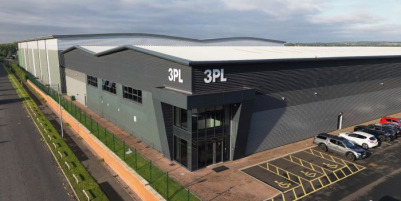-
Women Leading the Way in the UK Material Handling Industry - 1 day ago
-
LiftEx 2025 live from Liverpool - December 11, 2025
-
DATA ANALYSIS – THE FOUNDATION OF EVERY PEAK SEASON - December 5, 2025
-
Creative education specialists Creative Hut give 3PL full marks for onboarding excellence - December 5, 2025
-
Unlimited Industries raises $12M to build the AI construction company that will power America’s future - December 4, 2025
-
Scottish Leather Group gets full-support solution from Rushlift - December 4, 2025
-
Etaily lands strategic investment from Japan’s SMBC – bringing total funding to $24M for Social Commerce enablement platform - December 4, 2025
-
Winners lift their LEEA Awards and raise the industry - December 4, 2025
-
Prism eLogistics and Brand Angels Partnership Gives Brands the Full Package - December 3, 2025
-
New data shows Tesla in danger of losing its way as European consideration to buy Chinese cars jumps 16% in 12 months - December 3, 2025
Food raw material and ingredient costs have risen sharply over the past 18 months and food manufacturers have been forced to respond with consumer price increases in many instances. Today’s food shop costs around 12% more than it did a year ago according to September 2023 figures from the CPIH, caused as much by global events as post pandemic shortages. Some price rises were inevitable, but long term, there is a limit to how much these increased costs can be passed directly onto the consumer.
It is important that food manufacturers can identify as many ways as possible to maintain their profit margins, by implementing improvements to operational and process efficiencies.
One major cost centre for every food manufacturer is the warehouse, because it holds such a large volume of inventory – raw ingredients, packaging materials and finished goods. Being able to carefully control operations and processes within the warehouse can deliver big savings for food manufacturing businesses, which is why investing in a Warehouse Management System WMS software solution is a key business decision.
Some of the key advantages of introducing a WMS include the following:
- real-time visibility of inventory levels,
- ability to automate routine warehouse tasks,
- ability to optimise workflows including inventory management,
- tightly control stock rotation, order fulfilment and dispatch process,
- automate goods receiving and stock putaway,
- optimise stock picking for production and finished goods shipments.
This blog goes into these process improvements in detail, with an overview of the primary process improvements that food manufacturers can expect when they implement a WMS solution.
Key processes improved when food manufacturers implement a WMS
Inventory Management
Manufacturers have a lot of capital tied up in inventory and effective management is critical to maximising profits. WMS software automates inventory management leaving nothing to chance. The software allows businesses to track, monitor, and control their inventory levels in real-time. As many food manufacturers will be part of the BRC accreditation scheme the tracking of stock movements digitally removes a huge amount of paperwork from the process and allows real-time audit trail investigation when required. Operators can find the stock items they need quickly for production requests and customer orders. Sell by and use by dates are automatically managed and stock items rotated according to FIFO (first in first out) principles. This means any wastage resulting from products not being used before their end dates can be completely avoided. Shrinkage is cut through accurate, ongoing stock counting and inventory reconciliation. Stock replenishment is efficient because the WMS alerts operatives when inventory at a certain location falls below set limits, which minimises out of stock situations and avoids production delays.
Goods Receiving and Putaway
WMS software makes the goods receiving and putaway process very efficient because it avoids any need for paper in the warehouse. Data pertaining to deliveries and putaway rules is captured automatically and can be turned into management reports instantly. The software prompts operatives to find available locations, allowing up to 30% more stock to be stored in a warehouse through improved space utilisation. WMS systems also support real-time goods receiving processes that minimise handling efforts, including cross-docking.
Order Fulfilment
Getting the right products out to the right customers at the right time, for the right price remains the de facto target for every warehouse. Getting order fulfilment operations tightly optimised is critical and one of the biggest benefits of WMS software. Order processing and fulfilment is automatically optimised by having a wide range of picking and order allocation strategies to choose from. WMS software supports zone picking, batch picking, and wave picking, to suit many different order profiles. It also enables efficient order consolidation and packing options, with the ability to integrate automated labelling equipment, further streamlining the shipping process. This is a vital capability for food manufacturers, especially when handling foods with a limited shelf life.
Warehouse Design Optimisation
The way a warehouse is laid out has a huge impact on running costs and efficiency. WMS software supports optimising warehouse layout, by recommending the best locations for different inventory categories. As a result of gathering data on the fastest moving lines, inventory packaging dimensions, selection rates for different production runs and walk sequences, a WMS will recommend the best storage zones, bin configurations, and racking systems. Optimising warehouse layout will significantly reduce travel time and increases operational efficiency, having a direct impact on cost management.
Labour Cost and Performance Management
Labour costs are always one of the biggest overheads in a warehouse and using a WMS helps food manufacturers to effectively plan for upcoming resource requirements, schedule shift allocations and monitor productivity levels. Management can identify when a team member would benefit from additional training, or where additional labour resources are needed to shift a backlog. A WMS makes it possible to introduce productivity leaderboards and track operator performance in a light-hearted way, linking throughput rates to remuneration levels and running competitions.
Partial Automation and IoT Integration
A warehouse controlled with WMS software is one stage in an integrated supply chain that provides end to end visibility of operations. Best of breed software features an open API and can integrate seamlessly with automation systems including carousels and conveyors, storage and retrieval systems, automated packing arms, driverless totes and trolleys and weighing devices. Data can be captured on the spot to provide real time management information with tight control and full visibility, giving food manufacturers a full audit trail and product traceability.
Food manufacturers have one of the most compelling business cases for investing in a WMS. Unlike some warehouses dealing only with finished goods, manufacturers have to manage raw material inventory and their end products. It requires a finely tuned operation and at a time when costs must be very carefully minimised, it is an essential raw ingredient. Rather than battling with paper processes in your food warehouse, isn’t it time you switched to a WMS?

































